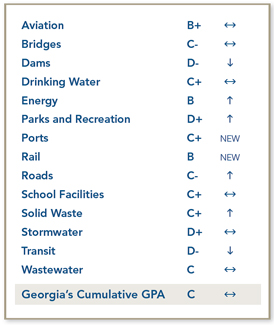Bipartisan Governors Coalition Presses Congress to Act on Transportation Funding
January 31st, 2014 | By: America's Infrastructure Report Card
This week, 17 Governors signed a letter urging congressional members to act to find a long-term revenue solution for the Highway Trust Fund and avoid a potential nationwide transportation funding crisis. The Highway Trust Fund, the funding mechanism that drives our nation’s investment in transportation infrastructure, is facing its fifth revenue shortfall since 2008. Motor fuel and truck excises supporting the Highway Trust Fund have not been adjusted in 20 years. As a result, the trust fund will be insolvent by the end of the year. “If Congress does not act to address this shortfall, we expect Federal support of highway and transit projects led by state transportation departments will cease in October,” said North Carolina Governor Pat McCrory. “Without renewed federal funding, states are left in a very serious financial crisis that impacts public safety and local economies,” McCrory added. Added Oregon Governor John Kitzhaber, “Investment in our transportation system is part of the backbone of a strong national economy. The Federal Government should do all it can to avoid the insolvency of the Federal Highway Trust fund. These dollars directly fund construction and maintenance projects, and provide needed construction jobs in states across the country.” On January 14, Oklahoma Governor Mary Fallin (R-OK), testified before Congress in her capacity as Chairman of the National Governor’s Association and urged Congress to take action. “States need federal funding stability and certainty to pursue long-term planning and project delivery,” said Governor Fallin. “All funding options must be on the table for evaluation because existing resources are no longer adequate,” she added. The following 17 governors signed the letter urging congress to act: Governor Mike Beebe (D-AR), Governor John Hickenlooper (D-CO), Governor Neil Abercrombie (D-HI), Governor Patt Quinn (D-IL), Governor Martin O’Malley (D-MD), Governor Mark Dayton (DFL-MN), Governor Steve Bullock (D-MT), Governor Pat McCrory (R-NC), Governor Maggie Hassan (D-NH), Governor Jack Dalrymple (R-ND), Governor John Kitzhaber (D-OR), Governor Tom Corbett (R-PA), Governor Lincoln Chafee (D-RI), Governor Dennis Daugaard (R-SD), Governor Peter Shumlin (D-VT), Governor Jay Inslee (D-WA) and Governor Scott Walker (R-WI). ASCE is an active member of the National Transportation Coalition, a bipartisan group of governors and transportation advocates working together to push Congress to take immediate action on vital federal highway legislation.Tags: congress, Funding, governors, highway trust fund, leadership, transportation
No Comments »
Georgia's C Infrastructure
January 13th, 2014 | By: Infrastructure Report Card
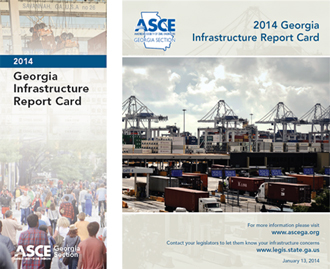 Georgia’s infrastructure has failed to improve over the last five years. In a new report, titled the 2014 Report Card for Georgia’s Infrastructure, the Georgia Section of the American Society of Civil Engineers (ASCE) awarded the state’s infrastructure a “C,” a grade unchanged from their 2009 Report Card. The lowest grade awarded was a “D-”, which went to the state’s dams and transit systems. The Report Card’s highest grade, a “B,” was given to Georgia’s energy and rail systems. Georgia’s growing population combined with cutbacks in infrastructure funding resulted in many of the low grades.
Specifically, the Report Card finds that Georgia is lagging in sustainable investment, including:
Georgia’s infrastructure has failed to improve over the last five years. In a new report, titled the 2014 Report Card for Georgia’s Infrastructure, the Georgia Section of the American Society of Civil Engineers (ASCE) awarded the state’s infrastructure a “C,” a grade unchanged from their 2009 Report Card. The lowest grade awarded was a “D-”, which went to the state’s dams and transit systems. The Report Card’s highest grade, a “B,” was given to Georgia’s energy and rail systems. Georgia’s growing population combined with cutbacks in infrastructure funding resulted in many of the low grades.
Specifically, the Report Card finds that Georgia is lagging in sustainable investment, including:
- Georgia ranks 49th in the nation in per capita transportation funding.
- Georgia is among the lowest in the country in transit spending per resident. According to the American Public Transportation Association’s 2010 Survey of State Funding for Public Transportation, Georgia spent just $0.63 per person in 2008. In comparison, New Jersey spent $119.52, Illinois spent $40.43, and North Carolina spent $7.94 per person in the same year.
- Georgia’s Safe Dams Program has faced over a 50% cut in staff since 2003, with each safety official now expected to oversee over 1,000 dams, or five times the national average.
- MARTA is the largest transit agency in the country to not receive state funding support for operations
- Georgia’s state motor fuel excise tax—which funds surface transportation projects—is one of the lowest in the United States
Tags: dams, grades, infrastructure, report card, state, transit, transportation, water
1 Comment »
Celebrating Infrastructure Successes in 2013
December 27th, 2013 | By: Infrastructure Report Card
Looking back over 2013, we have many successes in making infrastructure a priority to celebrate. Here are a few that really made our year: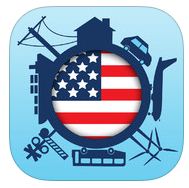 1. The 2013 Report Card for America’s Infrastructure was launched in March as a tablet and smartphone app gaining more traction with the media and decision makers than ever before and was even mentioned by President Obama during a “Rebuilding America” event at the Port of Miami.
2. Stephen Colbert showcased the uptick in America’s Report Card grades as a “Tiny Triumph” on the Colbert Report in April taking the infrastructure message to a whole new audience.
3. The Water Resources Development Act which will greatly help our ports and inland waterways deal with their pressing needs is currently in the hands of a House and Senate conference committee, and we hope to see it enacted early in 2014 (stay tuned!). It’s not too late to tell your member of Congress that this should be on Congress’ 2014 to-do list. Email them right here with a few clicks.
4. Major infrastructure funding legislative initiatives took off in several states including Maryland, Massachusetts, Pennsylvania, Virginia, Vermont, Wyoming, Texas, and Maine.
5. Several new bills were introduced that would start improving the nation’s infrastructure: The Partnership to Build America Act (H.R. 2084), which could re-shape the way infrastructure in the United States is financed; the UPDATE Act (H.R. 3636), which would increase investment in transportation infrastructure through an increase in the federal gas tax/user fee; the BRIDGE Act (S. 1716)/National Infrastructure Development Bank Act (H.R. 2553), both of which would facilitate infrastructure investment through creation of a national infrastructure bank.
1. The 2013 Report Card for America’s Infrastructure was launched in March as a tablet and smartphone app gaining more traction with the media and decision makers than ever before and was even mentioned by President Obama during a “Rebuilding America” event at the Port of Miami.
2. Stephen Colbert showcased the uptick in America’s Report Card grades as a “Tiny Triumph” on the Colbert Report in April taking the infrastructure message to a whole new audience.
3. The Water Resources Development Act which will greatly help our ports and inland waterways deal with their pressing needs is currently in the hands of a House and Senate conference committee, and we hope to see it enacted early in 2014 (stay tuned!). It’s not too late to tell your member of Congress that this should be on Congress’ 2014 to-do list. Email them right here with a few clicks.
4. Major infrastructure funding legislative initiatives took off in several states including Maryland, Massachusetts, Pennsylvania, Virginia, Vermont, Wyoming, Texas, and Maine.
5. Several new bills were introduced that would start improving the nation’s infrastructure: The Partnership to Build America Act (H.R. 2084), which could re-shape the way infrastructure in the United States is financed; the UPDATE Act (H.R. 3636), which would increase investment in transportation infrastructure through an increase in the federal gas tax/user fee; the BRIDGE Act (S. 1716)/National Infrastructure Development Bank Act (H.R. 2553), both of which would facilitate infrastructure investment through creation of a national infrastructure bank.
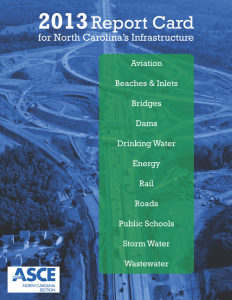 6. Five states – North Carolina, Oklahoma, Kansas, Missouri, and Washington – put out state-based Infrastructure Report Cards challenging their state’s leaders to get to work on the infrastructure issues in their area.
Thanks for your support in making these happen and we look forward to making 2014 an even bigger year for infrastructure!
6. Five states – North Carolina, Oklahoma, Kansas, Missouri, and Washington – put out state-based Infrastructure Report Cards challenging their state’s leaders to get to work on the infrastructure issues in their area.
Thanks for your support in making these happen and we look forward to making 2014 an even bigger year for infrastructure!
Tags: app, media, report card, state, state report cards, transportation, water
No Comments »
Meet IP3, the New P3 Where Citizens Are the Owners
December 19th, 2013 | By: Infrastructure Report Card
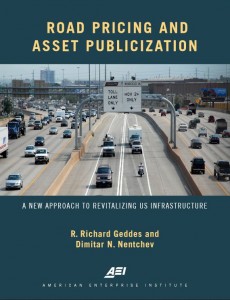 If you follow the infrastructure financing debate about how America is going to fund our future infrastructure needs, you have probably heard the term P3 or public-private partnership discussed as an innovative financing structure to utilize private investment in public infrastructure. However, with the release of the American Enterprise Institute’s new report, Road Pricing and Asset Publicization,” there is a new angle for the debate – the investment public-private partnership (IP3).
So what exactly is this IP3? Here’s how the report’s authors explain it: “The IP3 recognizes that you not the federal government or a private company—own roads that have already been built. And it offers you an annual payment for investing in them…. Under an IP3, a private company pays a public partner (like a state) a large upfront cash payment (called a concession) for the right to operate and collect toll revenue from an existing road network for a certain period of time. The IP3 locks away most of that concession payment—and most of the toll revenue—in a protected investment fund that pays an annual dividend to all households in the newly priced region. That helps offset the additional costs they will face from tolls, while recognizing that citizens are the true owners of the roads.”
America’s roads are definitely in need of repair so the more new ideas that are debated that’s all the better including P3s, gas tax changes and fixes, and all the others. While P3s are only one potential solution among the many, one thing is for certain – it’s time to start debating before the Highway Trust Fund is broke and many states lose half of their highway and bridge funding.
If you follow the infrastructure financing debate about how America is going to fund our future infrastructure needs, you have probably heard the term P3 or public-private partnership discussed as an innovative financing structure to utilize private investment in public infrastructure. However, with the release of the American Enterprise Institute’s new report, Road Pricing and Asset Publicization,” there is a new angle for the debate – the investment public-private partnership (IP3).
So what exactly is this IP3? Here’s how the report’s authors explain it: “The IP3 recognizes that you not the federal government or a private company—own roads that have already been built. And it offers you an annual payment for investing in them…. Under an IP3, a private company pays a public partner (like a state) a large upfront cash payment (called a concession) for the right to operate and collect toll revenue from an existing road network for a certain period of time. The IP3 locks away most of that concession payment—and most of the toll revenue—in a protected investment fund that pays an annual dividend to all households in the newly priced region. That helps offset the additional costs they will face from tolls, while recognizing that citizens are the true owners of the roads.”
America’s roads are definitely in need of repair so the more new ideas that are debated that’s all the better including P3s, gas tax changes and fixes, and all the others. While P3s are only one potential solution among the many, one thing is for certain – it’s time to start debating before the Highway Trust Fund is broke and many states lose half of their highway and bridge funding.
Tags: bridges, infrastructure, infrastructure report card, P3, roads, surface transportation, transportation
1 Comment »
Lighting Airports Runways with LEDs Saves Big for Raleigh
December 9th, 2013 | By: Infrastructure Report Card
America needs solutions to our infrastructure issues that can work today, and what if it’s as simple as switching out the lights? The replacement of the entire airfield electrical system at Raleigh-Durham International Airport (RDU) represents the first major air carrier airport in the United States to complete a full airfield conversion to FAA-certified LED airfield lighting. Beginning in 2008, the $20 million, two-year project replaced roughly 230 signs and 3,200 bulbs lighted with incandescent lighting — everything from taxiway edge and centerline lighting to runway centerline lights, obstruction lights, touchdown zone lights, runway end identifier lights, and elevated and in-pavement guard lights — with LED technology. The transition will save approximately $400,000 per year in energy and maintenance costs, including labor and parts. With AIP funds covering 75 percent of Phase One and North Carolina state funds and federal stimulus funds combining for Phase Two, maintenance savings alone are expected to recoup the airport’s portion of the project’s cost within 18 months. Find out more here on RDU’s website.Tags: Airports, energy, infrastructure, infrastructure report card, solutions, transportation
No Comments »
Public Opinion Shows Americans Open to Bus Rapid Transit
November 12th, 2013 | By: America's Infrastructure Report Card
Our friends at HNTB recently conducted their latest America THINKS survey, which polled a random nationwide sample of 1,127 Americans. The conclusion: Americans are open to new approaches to public transportation, such as bus rapid transit. But what is ‘bus rapid transit’? Simply, it is a new way of thinking about community bus service. According to HNTB, “Bus rapid transit is a lower-cost, more easily implemented alternative to a rail-based commuter transit system, yet still includes many popular features of rail-based public transportation, such as routes that are clearly laid out and run on a frequent and reliable schedule. BRT systems also often include low-emissions vehicles, electronic and/or automatic payment methods, and real-time arrival and departure updates.” In the 2013 Report Card for America’s Infrastructure, Transit earned a “D.” The Report Card found that 45% of American households lack any access to transit, and millions more have inadequate service levels. However, Americans who do have access have increased their ridership 9.1% in the past decade. Clearly, as demand for transit service increases, the question becomes how can cities, states, and communities meet this new challenge. HNTB’s study is encouraging in that it shows more and more Americans are seeing the connection between infrastructure investment and economic growth. Hopefully this trend will continue and we can all work together to raise our infrastructure grades.Tags: infrastructure, jobs, report card, transportation
No Comments »
Infrastructure Investment Wins at the Ballot Box!
November 6th, 2013 | By: America's Infrastructure Report Card
Yesterday voters in Maine and Texas both affirmed ballot resolutions resulting in increased investment in their local infrastructure. In Maine voters overwhelming approved Bond Question 3, 72% in favor to 28% opposed. Bond Question 3 gives permission to the State to borrow $100 million to fund transportation projects around the state which in turn would make the State eligible for at least $154 million in matching funds. Proceeds from the sale of these bonds would be administered by the Department of Transportation and would fund at least $49 million for road projects, $27 million for bridge projects and $24 million for multi-modal projects, including facilities and equipment related to ports, harbors, marine transportation, aviation, railroads (both passenger and freight), and transit (public transportation). In Texas Proposition 6 was also approved by a large margin – 73% to 27%. Proposition 6 authorizes the transfer of $2 billion from the state’s Economic Stabilization Fund (ESF or “Rainy Day Fund”) to a State Water Implementation Fund for Texas (SWIFT). The $2 billion one-time cash infusion will be used with already authorized bonds to provide low interest loans, credit enhancement, interest deferrals, and other financial assistance to projects approved in the State Water Plan. It is expected that the SWIFT will operate as a revolving fund; with repayments funding new loans, the program should provide the financing needed to implement the projects in the 50-year State Water Plan. ASCE supported both of these initiatives through various media channels and Key Alerts to Section members in both states. In Texas, letters to the editor from ASCE members in Texas were picked up by the Houston Chronicle and Focus Daily News and KLTV in East Texas ran a video spot in which ASCE member Vik Verma, P.E., was highlighted. In Maine, two newspapers, the Morning Sentinel and the Bangor Daily News each ran supportive editorials that cited the 2012 Report Card for Maine’s Infrastructure. The voters in both of those states have shown that infrastructure investment is a priority. So should you!Tags: elections, infrastructure, state, state report card, transportation, water
No Comments »
House Freight Panel Comes Out With New Report
October 30th, 2013 | By: America's Infrastructure Report Card
The Panel on 21st Century Freight Transportation, established by the House Transportation and Infrastructure Committee in April to examine the current state of freight transportation in the United States and how improving freight transportation can strengthen the U.S. economy, released its final report and recommendations yesterday. The special panel, led by Chairman John Duncan Jr. (R-TN) and Ranking Member Jerrold Nadler ( D-NY), also examined ways to increase the efficiency, safety and overall condition and performance of the nation’s freight network; how technology assists in the movement of freight; and financing options for transportation projects. To examine these issues, the panel held six public hearings and three roundtable discussions; in addition to touring freight facilities in Southern California, the Memphis region, the New York City and Northern New Jersey region, and Norfolk, Virginia. The final report concluded that Congress should:- Establish a national freight transportation policy and designate a multimodal freight network;
- Ensure “robust” public investment in all modes of freight transportation and incentivize additional private investment;
- Promote the development of projects that improve the movement of goods;
- Authorize dedicated, sustainable funding for multimodal freight projects through a grant process;
- Identify and recommend sources of revenue to provide investment in the nation’s freight network;
- Develo p specific funding options for freight transportation projects prior to Congress’s consideration of the surface transportation reauthorization bill in 2014.
- Air received a grade of D and has an estimated investment need of $134 billion;
- Bridges received a grade of C+;
- Transit received a D;
- Roads received a grade of D, and combined with bridges, and transit, have an estimated investment need of $1.7 trillion; and
- Rail received a grade of C+ and has an estimated investment need of $100 billion.
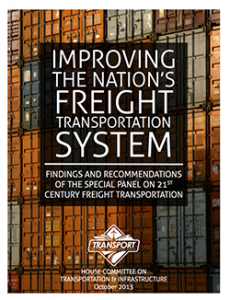 While the bipartisan report does not necessarily break any significant new ground, or specifically recommend new revenue sources for the ailing Highway Trust Fund, it does provide a strong foundation for MAP-21 reauthorization next year. Criticisms of the report for punting the funding solution to the Obama Administration are not unwarranted; however, the report does discuss a number of possible revenue sources, including public-private partnerships and a several freight-specific options, such as customs duties and a freight waybill tax. This bipartisan nature of the discussion on these topics does break new ground in a Congress where new revenue options have been shunned in the past. By laying out the problems with the freight system, as well as the growing concern for a lack of future revenue with a year to go until MAP-21 reauthorization, the report allows the critical conversation to commence. Additionally, it can prove as a critical education tool for new member of Congress who might not be as familiar with the impending insolvency of the Highway Trust Fund in the run up toward next September.
While the bipartisan report does not necessarily break any significant new ground, or specifically recommend new revenue sources for the ailing Highway Trust Fund, it does provide a strong foundation for MAP-21 reauthorization next year. Criticisms of the report for punting the funding solution to the Obama Administration are not unwarranted; however, the report does discuss a number of possible revenue sources, including public-private partnerships and a several freight-specific options, such as customs duties and a freight waybill tax. This bipartisan nature of the discussion on these topics does break new ground in a Congress where new revenue options have been shunned in the past. By laying out the problems with the freight system, as well as the growing concern for a lack of future revenue with a year to go until MAP-21 reauthorization, the report allows the critical conversation to commence. Additionally, it can prove as a critical education tool for new member of Congress who might not be as familiar with the impending insolvency of the Highway Trust Fund in the run up toward next September.
Tags: congress, infrastructure, transportation
No Comments »
Government Shutdown Highlights U.S. Inability to Solve Big Problems as Gas Tax Reaches 20th Anniversary
October 1st, 2013 | By: America's Infrastructure Report Card
Reston, Va. — The following is a statement from Gregory E. DiLoreto, P.E., P.L.S, D.WRE, president of The American Society of Civil Engineers (ASCE), regarding the current government shutdown and the 20th anniversary of the last federal gas tax increase: “Today marks the 20th anniversary since the federal gas tax was last raised to 18.4 cents per gallon in 1993. With the government shutting its doors today, this is a reminder of the pressing need for bipartisan solutions to America’s largest problems. “The shutdown of the federal government will have long-lasting negative effects on America’s already outdated infrastructure. With national parks closed, repair and replacement projects will be put on hold while parks lose needed revenue. We have furloughed one-third of the U.S. Department of Transportation employees, hurting our ability to asses, plan, and respond to needed surface transportation issues. This short-sighted shutdown creates economic uncertainty and halts continuing planning, forcing infrastructure projects to use stop-gap measures for long-term needs. “Regrettably, the shutdown is nothing new. The 20th anniversary of the federal gas tax shows that Congressional inaction has for far too long hurt American families and business. Given the growth and expansion of the U.S. over the last 20 years, one has to wonder the consequences of funding our 2013 infrastructure with 1993 dollars. “According to the Consumer Price Index, the costs of many household items have nearly doubled over the last 20 years. Some examples of the price differences between 1993 and today include:- A loaf of bread: 1993: $0.75, 2013: $1.41
- A pound of coffee: 1993: $2.50, 2013: $5.21
- A new car: 1993: $12,750, 2013: $31,252
ASCE Testifies Before Senate EPW
September 26th, 2013 | By: America's Infrastructure Report Card
ASCE President Greg DiLoreto, P.E., P.L.S, D.WRE, F.ASCE, testified before the Senate Environment and Public Works Committee yesterday about the state of the nation’s surface transportation infrastructure. The hearing entitled “The Need to Invest in America’s Infrastructure and Preserve Federal Transportation Funding” brought together infrastructure heavyweights to discuss revenue solutions for the Highway Trust Fund.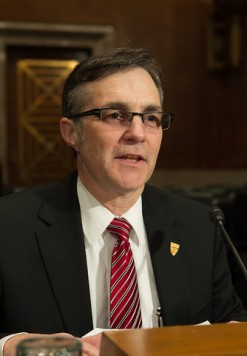 At the opening of the hearing Chairman Barbara Boxer (D-CA) raised the idea of replacing the gas tax with a “percentage fee that is paid for at the refinery level” and went on further to state that she is leaning toward doing away with the gas tax and replacing in with a sales tax. The suggestion was received with a grain of salt from panelists, who continued to urge that an increase in the gas tax is the fastest way to bring revenues back into the Highway Trust Fund. ASCE and others on the panel believe that all funding options must be considered for the long term viability of the Highway Trust Fund, however if revenue is not raised by 2015 transportation programs across the country will experience a 92% cut.
Highways and Transit Subcommittee Chairman and Finance Committee Chairman, Max Baucus (D-MT) spent his time during the hearing to share with the panel that he would like to mark up a tax reform bill this year that would include a fix for the Highway Trust Fund. Baucus also acknowledged that tax reform will likely not happen this year and therefore stated that another temporary transfer from the General Fund might be required. Baucus also made it clear that he thought fixing the Highway Trust Fund “could be an engine that pulls a train here” — in other words, moving as a stand-alone — “because people do want to solve this, and they know it has to be solved.”
At the opening of the hearing Chairman Barbara Boxer (D-CA) raised the idea of replacing the gas tax with a “percentage fee that is paid for at the refinery level” and went on further to state that she is leaning toward doing away with the gas tax and replacing in with a sales tax. The suggestion was received with a grain of salt from panelists, who continued to urge that an increase in the gas tax is the fastest way to bring revenues back into the Highway Trust Fund. ASCE and others on the panel believe that all funding options must be considered for the long term viability of the Highway Trust Fund, however if revenue is not raised by 2015 transportation programs across the country will experience a 92% cut.
Highways and Transit Subcommittee Chairman and Finance Committee Chairman, Max Baucus (D-MT) spent his time during the hearing to share with the panel that he would like to mark up a tax reform bill this year that would include a fix for the Highway Trust Fund. Baucus also acknowledged that tax reform will likely not happen this year and therefore stated that another temporary transfer from the General Fund might be required. Baucus also made it clear that he thought fixing the Highway Trust Fund “could be an engine that pulls a train here” — in other words, moving as a stand-alone — “because people do want to solve this, and they know it has to be solved.”



 */ ?>
*/ ?>




